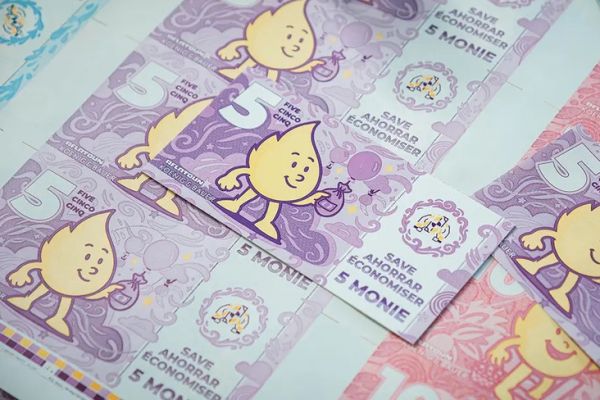Just as we read better on paper than on screen, we learn to manage our money better by handling banknotes than by viewing a balance on an app. At least, that's what Koenig & Bauer Banknote Solutions believes. The fiduciary subsidiary of German manufacturer Koenig & Bauer is now putting its industrial know-how to work in the field of financial education. In collaboration with the NGO Aflatoun International, which offers social and financial education to young people around the world, the company is launching the MoneyBox program, an educational device based on educational banknotes printed to real money standards.
Fake banknotes printed like the real thing
Deployed in 18 countries, including Rwanda, Mexico and Nepal, to more than 20,000 children and teenagers, MoneyBox is based on a simple tool: a box divided into four compartments ‚euros income, expenses, savings and ‚euros borrowing ‚euros and printed paper dummy bills. These bills have been produced using techniques usually reserved for currencies, such as micro-printing and visual security features.
The project takes direct advantage of Koenig & Bauer Banknote Solutions' core business, which is used to create a transmission tool rather than a transaction tool. "Koenig & Bauer Banknote Solutions machines and technologies ensure the circulation of most of the world‚euros banknotes; we consider it our responsibility to contribute not only through technology, but also through education and the promotion of equal opportunities, "¬ says Eric Boissonnas, Managing Director of Koenig & Bauer Banknote Solutions. "With MoneyBox, we use the banknote for what it really is: an instrument of self-determination" .
Messages printed on every ticket
The visuals on each bill are designed to illustrate fundamental principles. The income bill shows a young person planting a tree: an image that links financial gain, effort, patience and development. The entire system has been developed in conjunction with local teachers, to adapt to the economic and cultural contexts of the countries concerned. Content is translated into national languages and deployed with the participation of teachers, families and community leaders.
No program element is based on a digital interface. Learning takes place through direct manipulation, according to the principles of active pedagogy. "Children learn best by doing" says Kirsten Theuns, Director of Partnerships at Aflatoun International.
The banknote, learning medium and cultural object
The approach goes beyond education. It is part of a broader discourse on the place of cash in our societies. At a time when some governments are planning its eventual disappearance, Koenig & Bauer asserts that the banknote retains its social, educational and symbolic value. For most of the world's population, it remains the first contact with the economy.








